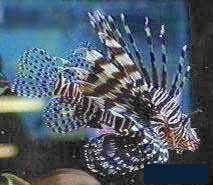

Pterois volitans {Lionfish}
DATA
Tank:-
Reef type tank with coral and algae. 24 Gallons
SG.:-
1.022
Temperature:-
26oC
Maximum Length:-
35cm
Swimming area:-
Utilises all tank space
Light:-
Occasionally bright
Temperament:-
Aggressive and can swallow fish
almost as big as themselves
Nutrition:-
Prefers moving prey so the food on a thread
technique can usefully be employed
here
Captain Jon Luk of the Starship Enterprise nust have the most widely travelled
fish of all
time. And YES! it is a lionfish which can be seen in the wall tank
in his ready room. Fiction
perhaps, but even now a group of Japanese scientists
are spening a lot of serious time and
effort with the intention of putting fish
into space to provide future astronauts with fresh
protein.
Widely know alternatively as Turkey fish; Scorpion fish and Dragon fish but
the title lionfish
is the most popular.They are very hardy, little prone to
disease but do like a lot of space in
which to manouvre. Found in most tropical
oceans they spend a lot of time crawling around
nooks and crannies searching
for the next meal. With their efficient camoflague network
they also lie about
waiting for an unwary fish to appear. With their cavernous mouths a fish
similar is size can easily be taken. Many feeder fish have been sacrifised to
this end but
they can be taught to take other foods although moving bait
appears attractive and the
"food on a thread method" can be utilised here as
the main criteria in feding being that
food should move. They can and do hunt
in packs.
Changes in water parameters are tolerated well by this species but of course is
not
recommended.
Divers and bathers are very wary of this fish because of the extremely venemous
spines. In
captivity the specimens can become quuite tame so handling needs to
be carried out with
caution.
Spawning has been observed and as the pair come together the released eggs and
sperm
float to the surface and become pelagic. Hatching time is unknown. Again
another instance
whereby the hobbyist can add to the store of knowledge if he
or she is successful in rearing
lionfish.
Species in this group include:-
Dendochirus-
barberi; biocellatus; brachypterus;
Parapterois-
heterus;
Pterois-
antennata; miles; radiat; spex; volitans;
Rhinepias-
aphanes;
Scorpaenia-
intermis; picta; sonorae;
Taenianotus-
triacanthus
;
If you wish further discussion or have any queries then please
E-Mail me.
Use Back Button to return to Previous Page
or click here for opening page ---



